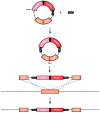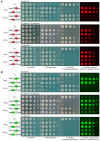A Chimeric ORF Fusion Phenotypic Reporter for Cryptococcus neoformans
- PMID: 39194893
- PMCID: PMC11355724
- DOI: 10.3390/jof10080567
A Chimeric ORF Fusion Phenotypic Reporter for Cryptococcus neoformans
Abstract
The plethora of genome sequences produced in the postgenomic age has not resolved many of our most pressing biological questions. Correlating gene expression with an interrogatable and easily observable characteristic such as the surrogate phenotype conferred by a reporter gene is a valuable approach to gaining insight into gene function. Many reporters including lacZ, amdS, and the fluorescent proteins mRuby3 and mNeonGreen have been used across all manners of organisms. Described here is an investigation into the creation of a robust, synthetic, fusion reporter system for Cryptococcus neoformans that combines some of the most useful fluorophores available in this system with the versatility of the counter-selectable nature of amdS. The reporters generated include multiple composition and orientation variants, all of which were investigated for differences in expression. Evaluation of known promoters from the TEF1 and GAL7 genes was undertaken, elucidating novel expression tendencies of these biologically relevant C. neoformans regulators of transcription. Smaller than lacZ but providing multiple useful surrogate phenotypes for interrogation, the fusion ORF serves as a superior whole-cell assay compared to traditional systems. Ultimately, the work described here bolsters the array of relevant genetic tools that may be employed in furthering manipulation and understanding of the WHO fungal priority group pathogen C. neoformans.
Keywords: Cryptococcus neoformans; amdS; fluorescent protein; fungal pathogen; fusion gene; reporter.
Conflict of interest statement
The authors declare no conflicts of interest.
Figures






Similar articles
-
Phenotypic characterization of HAM1, a novel mating regulator of the fungal pathogen Cryptococcus neoformans.Microbiol Spectr. 2024 Jul 2;12(7):e0341923. doi: 10.1128/spectrum.03419-23. Epub 2024 Jun 6. Microbiol Spectr. 2024. PMID: 38842336 Free PMC article.
-
amdS as a dominant recyclable marker in Cryptococcus neoformans.Fungal Genet Biol. 2019 Oct;131:103241. doi: 10.1016/j.fgb.2019.103241. Epub 2019 Jun 17. Fungal Genet Biol. 2019. PMID: 31220607
-
Broadening the spectrum of fluorescent protein tools for use in the encapsulated human fungal pathogen Cryptococcus neoformans.Fungal Genet Biol. 2020 May;138:103365. doi: 10.1016/j.fgb.2020.103365. Epub 2020 Mar 4. Fungal Genet Biol. 2020. PMID: 32145317
-
Cryptococcus neoformans: a sugar-coated killer with designer genes.FEMS Immunol Med Microbiol. 2005 Sep 1;45(3):395-404. doi: 10.1016/j.femsim.2005.06.005. FEMS Immunol Med Microbiol. 2005. PMID: 16055314 Review.
-
Connecting virulence pathways to cell-cycle progression in the fungal pathogen Cryptococcus neoformans.Curr Genet. 2017 Oct;63(5):803-811. doi: 10.1007/s00294-017-0688-5. Epub 2017 Mar 6. Curr Genet. 2017. PMID: 28265742 Free PMC article. Review.
References
LinkOut - more resources
Full Text Sources
Research Materials

